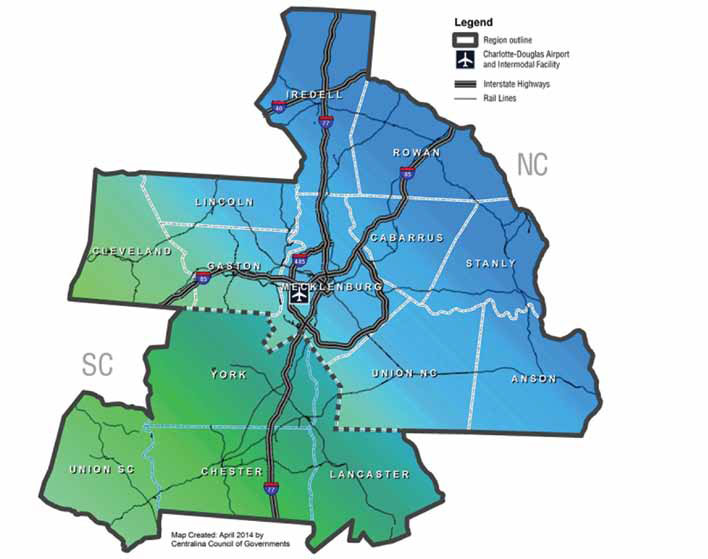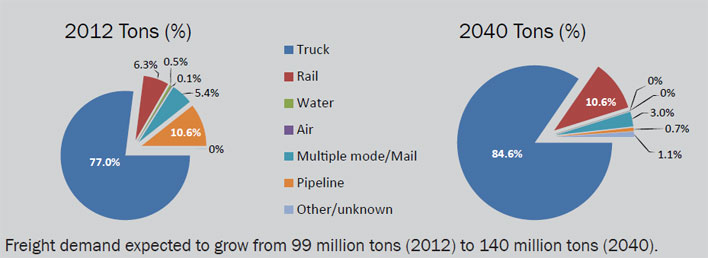U.S. Department of Transportation
Federal Highway Administration
1200 New Jersey Avenue, SE
Washington, DC 20590
202-366-4000
Freight Economy
Date: March 4, 2016
Our Host: Charlotte Chamber of Commerce
| HIGHWAYS | I-77, I-485, US74 | |
| RAILROADS | Norfolk Southern Railroad, CSX | |
| AIRPORTS | Charlotte Douglas International | |
| WATERBORNE | Port of Wilmington and Port of Morehead City |

Source: Centralina Council of Governments
| Commodity | Value (millions $) | % of total |
|---|---|---|
| Machinery | 40,146 | 14% |
| Pharmaceuticals | 33,334 | 12% |
| Textiles/leather | 24,851 | 9% |
| Electronics | 24,144 | 9% |
| Mixed Freight | 24,018 | 9% |
| All commodities | 277,190 | 100% |
| Commodity | Tons (thousands) | % of total |
|---|---|---|
| Gravel | 16,526 | 12% |
| Waste/scrap | 11,479 | 8% |
| Nonmetal min. prods. | 11,288 | 8% |
| Other foodstuffs | 8,535 | 6% |
| Plastics/rubber | 6,719 | 5% |
| All commodities | 139,702 | 100% |
| Trade partner | Tonnage | % of total |
|---|---|---|
| North Carolina | 13,965 | 31% |
| South Carolina | 8,965 | 20% |
| Georgia | 3,827 | 8% |
| Virginia | 2,483 | 5% |
| Tennessee | 2,191 | 5% |
| Total outbound | 45,592 | 100% |
| Trade partner | Tonnage | % of total |
|---|---|---|
| South Carolina | 11,982 | 21% |
| North Carolina | 8,396 | 15% |
| West Virginia | 3,700 | 6% |
| Georgia | 3,595 | 6% |
| North Dakota | 2,843 | 5% |
| Total inbound | 57,794 | 100% |
*2012 from FAF4, 2040 from FAF3

The Charlotte Region will see multimodal freight activity grow by forty percent between 2012 and 2040.
The majority of Charlotte's freight activity is domestic (77% by value and 79% by tonnage). International freight will almost double by both value and tons by 2040.
Charlotte has a higher share of freight activity moving by truck (77%) as compared to the nation (70%; tonnage based). Key truck corridors are I-77 and I-85.
Charlotte's freight activity and regional freight role is closely connected to two key maritime ports - Port of Wilmington and Port of Morehead City.
The Charlotte region has seen a population boom (65% growth between 2000 and 2010) in the last decade.
The sectors of trade, transportation and utilities account for almost 20% of jobs in the Greater Charlotte region.
Local estimates project air cargo will double at the Charlotte-Douglas International Airport by 2030 which has on-site air cargo facilities operated by UPS, FedEx, Emory Worldwide and DHL.
More than 100 distribution centers are located in the Charlotte region. Charlotte is also home to one of two inland freight terminals in North Carolina. The Charlotte Inland Terminal (CIT) serves the I-85 and I-77 corridors and is a 16 acre facility with space to stack 391 containers and 292 parking spaces.
Rail currently accounts for 6% of Charlotte's freight tonnage, but this share is anticipated to grow to nearly 11% by 2040. Charlotte serves as a regional rail hub for both Norfolk Southern and CSX. In January 2016, CSX announced it will spend $150 million to build an intermodal terminal in eastern North Carolina.
North Carolina is home to the fourth largest active duty population in the country and 50% of the east coast’s active duty ground combat units--Fort Bragg has the closest presence to the Charlotte region. The DOT and region are working to ensure the state's transportation infrastructure aligns with military logistics needs.
Sources for Freight Facts: FAF, Centralina COG and Charlotte MPO.
To view PDF files, you can use the Adobe® Reader®.